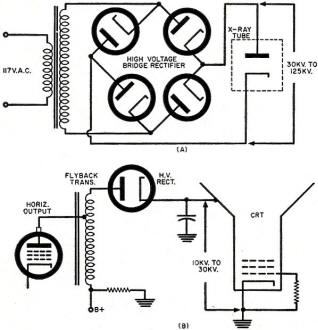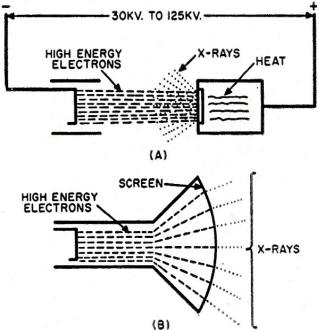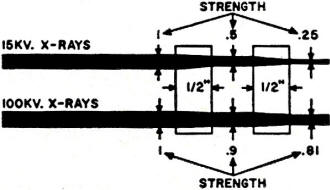|
Most of us are likely familiar
with the ongoing debate over whether radiation from cellphones, Wi-Fi routers and
laptop computers, cell towers, smart meters, and other such modern gadgetry is harmful
to humans. It is not ionizing radiation like nuclear decay, but there are heating
effects that can cause damage under the right conditions. One week news breaks from
the latest organization shocking the public with proof of tissue cell damage to
brain, hand, face, eyeball, and groin tissue (from laptops). The next week brings
a counter report refuting apocalyptic claims of previous studies... then the cycle
repeats. Early in the age of ubiquitous wireless devices, those seeking to mitigate
worries of radiation argued - somewhat correctly - that enough time had not yet
passed to collect statistically meaningful data. If significant harm could be proven
right away, dismissing the empirical results would be hard to do, but there were
no burn holes in people's brains or clouded eyeballs that began appearing soon after
cellphone use. Now, nearly three decades have passed since exposure began on a widespread
basis, and we still have no hard evidence of a crippled population. This scenario
is not new; we've been there before back in the 1950s when color television first
appeared. Voltages needed for early picture tubes was extremely high - sometimes
in the 35-50 kV range, and the emission of x-rays caused a near panic once
word got out. The TV industry put a lot of time and money into mitigating that fears
people understandably had. To their credit, at the same time they put a lot of time
and money into developing picture tubes that worked at lower voltages and on more
effectively shielding viewers from x-radiation. This article from a 1958 issue
of Radio & TV News magazine is typical of the effort put forth to educate
the public and the television industry sales and repair forces about the issue.
X-Rays from TV Sets - Are They Harmful?
 By Charles R. Maduell, Jr. By Charles R. Maduell, Jr.
How safe is this technician, regularly exposed to many sets at close range?
Do viewers and technicians have a real cause for worry? What bearing does prolonged
exposure have?
There have been many statements and questions of late concerning the x-rays that
may emanate from television picture tubes. To evaluate the situation, there must
be some understanding of what is involved.
Editor's Note: Data on possible harmful effects of x-radiation
from TV receivers has been as scarce as questions on this subject have been plentiful.
The author is well equipped to shed needed light: he has been trained as a physicist;
he services TV and other electronic gear - including medical electronic equipment;
he has access to the required measuring equipment; and he knows how to use it.
First, it might be advantageous to describe how x-rays are produced, what they
are, and how they act. They are actually electromagnetic rays, similar to radio
waves, but of extremely short wavelength. As such, they travel at the speed of light.
Their effects, production, and transmission through media such as glass, metals,
the human body, etc., bear some relation to the action of radio waves or light radiation.
X-rays are produced within the atom. When high-velocity electrons, such as those
produced from a hot cathode and accelerated by a high voltage, are made to hit a
target, x-rays result. Of course, in any x-ray tube, most of the high energy of
the electrons is dissipated in the form of heat and less than one per-cent actually
penetrates the atoms of the target material to change the energy into x-rays, See
Fig. 1A. A very complicated part of the electron theory is used by physicists to
describe how high-energy electrons lose their energy to an atom, making the atom
give off x-rays. It is not important to go into detail here, except to state that
there is a definite relationship between the voltage across the x-ray tube (giving
the electrons their high velocity and therefore their high energy) and the wavelength
of the x-rays produced. In medicine, x-rays produced by electrons accelerated at
from 15,000 volts upward have medical value and pathological effects.

Fig. 1 - The circuit for generating x-rays (A) is a big uncle
to the more familiar television high-voltage circuit of (B).
The so-called "soft" x-rays are produced by electrons which are accelerated by
voltages of from 15,000 to 30,000 volts. X-ray equipment for "picture taking" is
usually shielded in such a manner that these soft rays rarely leave the instrument.
The x-rays used for picture taking are accelerated by voltages which vary from 30,000
to 125,000, the latter figure being the present upper limit of x-rays for medical
picture taking. Higher voltages are, however, used in x-ray therapy (treatment),
as high, in fact, as one-million volts. In industrial x-ray instruments, voltages
on the order of hundreds of thousands of volts are employed, but such equipment
has been replaced to a great extent by spontaneous atomic radiations from isotopes,
which is another subject!
In general, however, x-rays can be produced by high-energy electrons hitting
any material, be it a metal target or the screen of a television set. It is a fact,
therefore, that perhaps one per-cent of the electron energy that produces the picture
on the television screen makes the screen material give off x-rays of the so-called
"soft" variety of from 15,000 to 30,000 volts. Compare Figs. 1A and 1B. This has
given rise to needless worry which can best be dispelled by examining the problem.
The penetrating power is directly related to the wavelength (and therefore the
voltage) of the x-rays. An x-ray technician selects a higher kilo-voltage to penetrate
a stout person than for a thin person, and to penetrate a chest than would be used
on a hand. The quantity or density of x-rays, however, is dependent on several factors
which we will now examine.
First, x-rays behave much like radio waves emanating from an antenna. If a greater
r.f. current is fed into the antenna, more radio waves will be given off. Similarly,
if a higher current flows through an x-ray tube, more x-rays are given off. The
quantity or density of the x-rays produced at the screen of a television picture
tube is directly related to the current through the tube itself; and penetrating
power or hardness to kilo-voltage.

Fig. 2 - In an x-ray tube (A). a heavy stream of electrons is
concentrated on a small area. In a picture tube (B). a lighter stream is diffused,
by deflection, over the entire screen of the cathode-ray tube.
In an x-ray tube, the electron beam is focused on a very small target area at
a current of several hundred milliamperes. Such x-rays are of high density and heavily
concentrated at a single spot. In a television picture tube, on the other hand,
the current is from a few hundredths to thousandths of that used in an x-ray tube
(100 μa. compared with 50-500 ma.). Although the beam is focused on a similar
small spot, the spot is scanned, hence, the small amount of x-rays produced are
distributed over the entire screen area. See Fig. 2.
The second factor affecting quantity is time. If two drops of water per second
are allowed to drip into a glass and two hundred drops per second from a second
faucet into another glass, if the first faucet dripped for 100 seconds and the second
faucet for one second, at the end of the experiment both glasses would contain the
same amount of water.
In the case of a television picture tube, although the current is rather low,
the instrument is on for many hours at a time. On the other hand, an x-ray machine,
with its high current, is usually on for only a small fraction of a second. Simple
arithmetic will show that a television picture tube operating at 30,000 volts with
a current of 100 μa., will produce the same quantity of x-rays in an hour as
an x-ray generator using 100 ma. and operating at 30,000 volts will produce in slightly
more than 3 1/2 seconds.
The quantity of x-rays is dependent n several additional factors, two of which
are very important to us. The first factor is distance. X-rays, just like light
or radio waves, travel in straight lines, They can, however, be deflected by intervening
objects but not to the extent that light or radio waves can be deflected. They do,
however, suffer a loss which is governed by the so-called "inverse square law."
An x-ray beam has one fourth its strength at double the distance, just like radio
waves. Therefore, to produce the same effect four feet from the tube as was originally
produced at two feet, the quantity (amount) would have to be increased by four (by
increasing the current through the tube four times or by quadrupling the time).
The viewing distance for a television picture is two to three times that involved
in taking x-ray pictures but is many times the distance in x-ray therapy, where
the tube is often almost in contact with the part being radiated.
What is of most importance, however, is the relative absorption of x-rays through
materials. It is known that in so-called "Grenz ray" therapy, 15,000 to 30,000-volt
soft x-rays are used. In order to get these x-rays out of the tube, it is usually
necessary to have special tubes constructed with extra thin glass or beryllium windows.
Grenz rays are used in surface therapy, in treatment of skin diseases, and occasionally
in cases of internal injuries involving areas near body orifices through which the
tube can be inserted. These rays are heavily absorbed by surface layers of body
tissue and do not penetrate much beyond the skin.
In an x-ray machine of the standard radiographic type, practically all the radiation
of less than 30,000 volts is filtered out through the glass of the tube and the
oil in the tube housing. Whatever remains is usually filtered out by 2 mm. of aluminum
in the form of a small aluminum plate less than 1/10 inch thick placed directly
in the path of the x-rays.
X-rays are absorbed in what mathematicians call an "exponential" fashion. If
a filter 1 mm. thick absorbs 90 per-cent (transmitting 10 per-cent) then a 2 mm.
filter of the same material will not absorb all the rest but will absorb 90 per-cent
plus 9 per-cent, or 99 per-cent. This brings us back to our original point concerning
TV set radiation.
The glass on a television picture tube is fairly thick, in fact it is ten to
fifteen times thicker than the glass in the window portal of an x-ray tube. Since
soft x-rays are more easily absorbed than hard and since the x-rays produced in
a television picture tube are all of the soft variety, only extremely small amounts
of x-rays would reach the outside of the glass. See Fig. 3. Even these would probably
be completely lost in the safety glass and the wood or metal cabinet of the instrument.

Fig. 3 - When x-rays pass through such media as glass, there
is much more absorption of soft x-rays (top diagram) than of the hard radiation
shown below.
Experimental analysis indicates this to be true. An "R" meter chamber (used for
measuring x-rays for therapy dosages) was taped to the front of a television picture
tube and left there for several hours. The x-ray-producing (and light-producing)
electron beam was less than an inch away but no measurable radiation was indicated
on the "R" meter.
A somewhat different situation was found, however, when the same experiment was
tried in the high-voltage cage near the rectifier tube. These tubes are constructed
with thin glass envelopes and therefore some x-rays should be measurable. We discovered
that a reading taken one inch away from the 1B3 tube operating at 16,500 volts indicated
0.01 roentgen unit of x-rays per hour.
In a TV service shop where from 5 to 10 sets are on all day, a radiation detector
chamber placed less than 10 feet from the sets indicated approximately 0.05 roentgen
(50 milliroentgens) of radiation in one month. This is not much more than the normal
background count, due to all sources of radiation, in many parts of our country.
Thus it can be stated that no appreciable x-rays were found in the TV service shop
checked by the author.
The radiation standard adopted for the guidance of x-ray personnel specifies
that exposure to no more than 100 milliroentgens per week comes within allowable
limits. A hand placed within the high-voltage cage near the 1B3 would receive this
dosage in ten hours. Since no one would willingly place his hand in the high-voltage
cage for even one second with the power on, the radiation "hazard" is virtually
non-existent. No sane person would take such a chance with the voltages involved,
let alone the radiation.
If you are still worried about radiation from your TV set, here is a simple and
inexpensive test that should convince you. Purchase a small dental x-ray film from
your dentist - he might even give it to you. Place a paper clip on the edge of the
film. Place this film in the high-voltage cage of your TV set - being careful to
mount it away from the high heat of any of the components and being sure the paper
clip is attached firmly so that it won't fall across the tube pins - and leave it
for three or three weeks. Alternately, you can tape the film to the face of the
picture tube for about a month. After the required time has elapsed, develop the
film or talk your dentist into developing it for you. If a shadow of the paper clip
appears on the film - you might then have cause to worry about x-ray radiation.
The result of the author's experiments boils down to this one fact - protection
from the radiation "hazard" of television sets amounts to the self-same procedures
involved in avoiding -electric shock. When repairing a TV receiver and replacing
the chassis in its cabinet, be sure to restore all of the original hardware as insurance
against radiation for both you and your customer.
Posted NOvember 29, 2019
|













